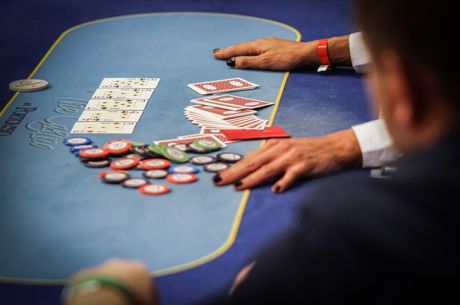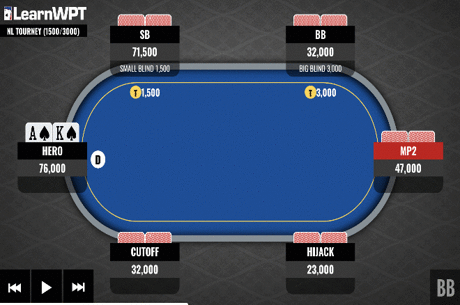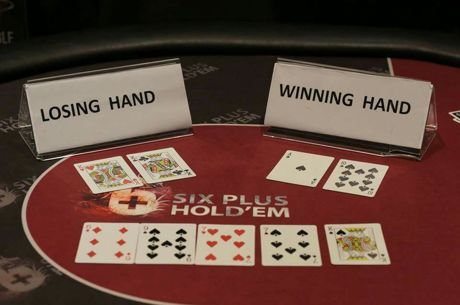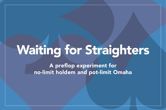Tommy Angelo Presents: Checking Behind on the Flop with a Straight Draw

If the objective were to cash in on the equity of your starting hands more often than you do now by seeing more rivers than you do now, what would you change? If the objective were to win steady money at poker for life while experiencing the least possible amount of variance and stress, how would you play?
What if both questions had the same answer? How sweet would that be? For me, sweet enough to crave.
Say you have 9-8 on the button. Someone opens, someone calls, and you call.
The flop comes 7-6-2. You flop an open-ender.
They both check to you. Do you check or bet? Why?
Or let's say you open the pot, you flop an open-ender, you are last to act, and you get checked to. Do you continuation bet?
I used to bet in all those spots. Now I don't. The change was gradual, spanning 10 years, from 2003 to 2013. It started when, after 25 years of poker pain, I decided to make my happiness the top priority when making poker decisions. This included everything from bankroll decisions to poker room choices to betting decisions. Now I painlessly play straight draws in position. Here's how, and why.
The Preflop Scene
I open the pot, one or two players call, and I have position, meaning I will be last to act on the flop, turn, and river. We'll begin our analysis on the flop, right after both players check to me, and we'll look at the most common trajectories from there.
But first, two clarifying notes:
- We're assuming three-way pots will come down to heads-up on the first street that has action.
- Below I write in the language of three-way pots. All of this also applies to heads-up pots.
PATH ONE: I check behind on the flop. On the turn, I miss, and someone bets.
My default is to raise — to represent either a big hand that I slow played on the flop, or a hand that got there on the turn. They almost always fold, because if they have a strong hand on the flop, like a set, they tend to check again on the turn. If they have a small piece of the flop, like one pair, they tend to bet out on the turn. And then I raise, and they are faced with the possibility of drawing dead or slim against a rock, so they fold their one-pair hands, correctly, after betting out, correctly. My opponents feel good about their decisions, and about their reads on me. In other words, my cover is intact. They still don't know I'm a bandit.
If I decide to call the turn (instead of raising), this also works out well, mathematically, when these conditions are met: the stacks are the right size, the opponent is not likely to fold to my raise, and the opponent is likely to bet into me on the river.
PATH TWO: After checking behind on the flop, I make my straight on the turn and someone bets into me.
I call. This is a no-brainer since they almost always fold when I raise in this spot, and I don't want them to fold.
PATH THREE: I check behind on the flop, make my straight on the turn, and they check to me again.
I bet lots of times with nothing in this spot, so I'm not going to not bet with something. I bet!
Let's say I get check-raised on the turn. This is lovely synchronicity because when my opponent's hand is strong enough to check-raise the turn, it means he has a hand that I will successfully ambush by checking the flop and making my hand on the turn.
Had I bet the flop, I would have served up a soft lob to my opponent who could then push me off my draw before the river by check-raising the flop and betting the turn, with or without a good hand.
Folding draws on the turn after betting the flop was a source of grief for years. I'd fold to the turn bet, correctly, and then hang my head while I fantasized about what might have been had I made it to the river and made my hand. I gather in the huge pot... my freshly tilted opponent reloads... I tip three dollars...
Remember the pain-reduction objective I mentioned earlier? This is what I was talking about — eliminating predictably painful patterns, without reducing my hourly win rate.
The checking-behind line also appeals to my math bones. When it comes to winning or losing a big pot, to me it's all about the odds at the moment the biggest bets go in. For example, if the money goes in when I'm a 70-30 favorite, that's good. I won that hand, in my mind, no matter who ends up with the pot.
The best possible result in this game-within-the-game is to put in zero percent of my stack when I have the worst hand, and 100 percent of my stack when I have the nuts. Checking behind on the flop with a draw is the only way I can achieve a perfect score.
PATH FOUR: After checking behind on the flop, I miss on the turn, and they check.
I might bet and I might not. Here the decision to bluff or not will be based on board textures and spidey sense.
PATH FIVE: I check behind on the flop, I pick up a pair on the turn, and it's checked to me.
If I make a pair on the turn to go with my straight draw and I've been checked to twice, I almost always bet. This is left over from all those years of playing fixed-limit holdem. Back then, anytime I had one pair, I assumed it was the best hand until I received some indication from the betting to believe otherwise. In this pattern, my opponent has thus far called preflop, checked the flop, and checked the turn. I've been given no reason to believe that my pair is beat. So I bet my pair. It's not a bluff, or a misrepresentation. It's an impulse purchase. I am buying mathematical protection at a time when I probably need some. And with only one card to go, each of my dollars applies the maximum theoretical pressure.
PATH SIX: They check to me on the flop and I bet.
I have 9-8 on the button. I open to 4x and both blinds call. I flop an open-ender or a double-gutter. They both check to me, and this time I decide to c-bet, and they both fold. Game over! I win! With 9-high! I play good!
But really, all I did was cash in on the value of being last aggressor and last to act at the same time. I've won so many pots that way. And so many times, from the blinds, I've check-surrendered to the button.
So when I check behind on the flop with a straight draw, I am leaving money on the table, because some percentage of the time, both opponents would have folded to a c-bet. Is the fold equity that I sacrifice greater or lesser than the value of the benefits of checking behind?
I've looked at checking-behind-on-the-flop-with-a-straight-draw from both sides now (sorry, Joni), and my gut tells me it's close. So, why did I gravitate toward checking behind?
We are drawn to the volatility of poker, the variance, the small swings, the big swings. Riding the poker rollercoaster is exciting, and sometimes satisfying. Winning at a steady rate for years on end provides satisfaction too, of a different sort, like riding the High Roller Observation Wheel in Vegas.
In the short run, the buzz we love comes from fluctuation. The fluctuation has a value, for the buzz it provides. Which is why it can be a good buzz-bargain to play slots, even when the gamester knows it's a losing battle.
Many times in years past, I have lost money by satisfying my craving for fluctuation, which caused me to fluctuate further, in the worst ways. Checking behind on the flop with a straight draw is like folding the small blind in limped pots. It's a tool in my fluctuation-reduction toolbox. When I check behind, I take the road less frazzled. And that has made all the difference.

World-class coach and author Tommy Angelo is now offering poker pain relief to everyone. You can schedule a call to talk to Tommy about bad betting, bad quitting, bad tempers, or whatever else is hurting your game. Just go to tommyangelo.com. Angelo's first book, Elements of Poker, was called "the seminal poker text of the 21st century" by The London Times, and it has revolutionized the way serious players approach the game.









